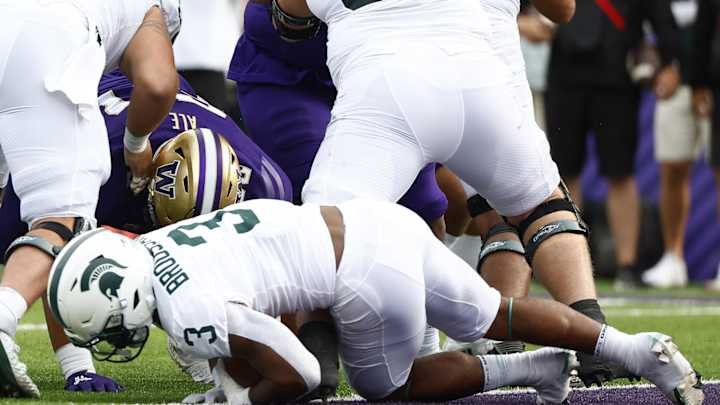Three Ways Michigan State's Run Game Can Improve In Big Ten Play

In this story:
We are a quarter of the way through the college football season and Michigan State just ended non-conference play with a loss at Washington. While playoff and conference championship dreams aren’t crushed, the Spartans received a reality check in Seattle.
While Michigan State only ended up losing to Washington by 11 points, 38-29, the Spartans trailed by three touchdowns for what felt like most of the game. While programs never want to lose games, maybe the nature in which MSU was beaten was a blessing in disguise for the Spartans.
For one thing, it provides a chance for head coach Mel Tucker and offensive coordinator Jay Johnson to reevaluate their offensive approach.
The main talking point after the game has been Michigan State’s continued poor pass defense, but the Spartans’ run offense was subpar too against the Huskies. The Spartans finished with just 42 rushing yards on 29 carries as a team, which was very underwhelming.
Michigan State’s offensive line allowed five tackles for loss, and the longest run was by quarterback Payton Thorne for 21 yards. Neither running backs Jalen Berger and Jarek Broussard had a rush over eight yards.
This could end up being a problem, as Washington was considered to have a good, but not great defense. Not to downplay the Huskies performance, but MSU should expect to see better defenses from Michigan, Ohio State and Penn State later this season.
Entering Big Ten play, here’s three ways the Spartans can help improve their run game.
1.) Better Rotation Of Tailbacks
So far this season, Broussard and Berger have seemed to rotate in and out during the same drives, and this could prevent one of them from getting into a good rhythm. For instance, if Berger breaks a tackle and bursts forward for a first down, I’d rather see him continue with the drive rather than subbing in a “fresh body” at his position.
I think there are mental advantages to letting one guy play the majority of the snaps on a single possession, rather than switching back and forth every other play or so.
Broussard is looked at as more of a passing down back, which is why he and Berger rotate a lot. But, Berger has made some nice catches this season out of the backfield and is the better pass blocker of the two, no doubt because of his size.
Last season, Michigan State rotated Kenneth Walker III during passing downs with Jordan Simmons and Harold Joiner, but that was because Walker was not the best pass-catching option at tailback, and was the worst pass blocker of the three. That’s not the case this year with Berger.
2.) Better Patience By Tailbacks
Not to dwell on last year’s team yet again, but that was one of Walker’s best abilities – to wait for the offensive line to create a hole and burst through for a big gain. This ability made him the best running back in the country.
The saying ‘patience is a virtue’ is especially true for running backs. While Berger had success against Western Michigan and Akron, he didn’t have much patience against Washington. Part of that could be the fact that he hasn’t faced competition of that caliber in over a year, after having been dismissed from Wisconsin.
It may take time for Berger to relearn this trait and to develop better chemistry with his offensive line. But, against better competition, the spaces between the tackles won’t be there immediately and sometimes won’t be there at all. If Berger can slow the game down a bit and wait for those opening, it could have a positive effect on Michigan State’s run game.
3.) Offensive Line Must Improve
This feels like a no-brainer, but it has to be mentioned. The Spartans' O-line had a lot of trouble withstanding Washington’s defensive front.
Michigan State was outmatched in many of its one-on-one battles with Husky defenders, and it showed. Washington linebacker Cam Bright was one of the opposing players who caused problems for MSU’s O-line. The Huskies played more physical, and that can’t make Tucker or offensive line coach Chris Kapilovic happy.
It’s possible that MSU left tackle Jarrett Horst is still recovering from the injury that ended his 2021 season – he had trouble off the edge all night. Guard Brian Greene still seems to be getting accustomed to the new offense as well. As two of the more veteran players on this squad, both guys need to elevate their play going forward.
Final Thoughts
Michigan State’s run game was the backbone of the team last year. If the Spartans are going to duplicate or improve upon 2021’s success, establishing the run game is necessary. Thorne played well and showed the offense can revolve around the passing game, but 42 yards on the ground isn’t enough. MSU needs to average a bare minimum of around 150 rushing yards per game for this offense to reach its full potential.
Tucker, Johnson and Kapilovic don’t have much time to figure out the run game issues that popped up against Washington. Michigan State’s bye week doesn’t come until after the Spartans play Minnesota, Maryland, Ohio State and Wisconsin. The Big Ten East gauntlet also includes Michigan and Penn State, so changes need to happen sooner rather than later.
